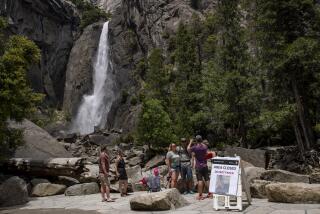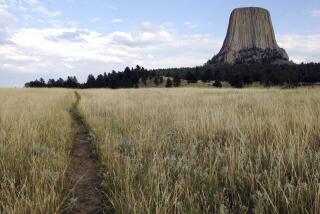Granite slabs the size of office towers crash down in Yosemite, sparking fear and amazement

Sharon and Doug Hansen were in Yosemite National Park watching climbers on El Capitan when they heard the rock slide begin. Doug began filming about a minute after the slide began and captured the billowing clouds of dust that blew through the trees
Yosemite National Park this week saw an awesome display of Mother Nature’s power as massive granite slabs the size of office towers crashed down, killing one person and leaving witnesses stunned.
Park officials said Friday that despite the rockfalls, El Capitan remains safe, and climbers continued their treks.
The wife of a man injured during the latest rockfall at Yosemite National Park’s El Capitan monolith on Thursday described the harrowing moments in which debris blanketed their vehicle and sent them and others scrambling for cover.
Rachel Evans was with her husband, Jim, who was driving, and her sister and brother-in-law when massive chunks of rock separated from El Capitan and dropped hundreds of feet to the ground below, Evans told KSEE.
“Something came through our sunroof, but we didn’t know it was closed. We didn’t know what had happened, but it shattered and dust just poured in,” a visibly shaken Evans told the station. “So we were trying to outrun it and was like, ‘Go! Let’s go!’ and at the same time, my husband reached up and was like, ‘Oh, my head. My head,” because he was bleeding profusely.”
Thursday’s fall was believed to be larger than the deadly fall the previous day, when a British tourist was killed and his companion seriously injured.
“It could’ve been a lot worse,” said Ken Yager, president of the Yosemite Climbing Assn., who saw the aftermath of Thursday’s incident. “From what I hear, we got really lucky.”
A rock the size of a golf ball could be fatal, he said, and he estimated Thursday’s fall was “10 times bigger” than the colossal chunk that broke off a day earlier.
“That anybody survived, it just blows my mind,” he said.
Yager was coordinating a park cleanup when he saw a dust cloud, from about a mile away, billowing from the formation. Immediately, his phone began buzzing as people tried to figure out what had happened and emergency crews rolled to the scene.
“After [Wednesday], I guarantee there’s no climbers climbing near that rock,” he said. “If they were, they’re crazy.”
On Wednesday, a sheet of granite the height of a 13-story building — about 130 feet long, 65 feet wide and in some sections 10 feet thick — separated from the rock face and dropped to the base of El Capitan, officials said.
A couple were at the base of the cliff at the time of the crash. The man who was killed was identified Thursday as Andrew Foster, 32, of Wales, according to the National Park Service. His wife was airlifted to a hospital; her name has not been released.
The slab fell from a spot about 1,800 feet above the Yosemite Valley floor, officials said.
It was one of seven rockfalls that occurred in a four-hour span on a bright and sunny afternoon. In total, officials estimate about 1,300 tons of rock fell from El Capitan on Wednesday.
About 30 climbers were on El Capitan just before 2 p.m. Wednesday when the slab crashed down from the popular East Buttress climbing route, officials said.
The release point appears to have been near the waterfall route, where the seasonal Horsetail Fall flows in the winter and spring. The site draws experienced climbers from around the world seeking to scale the granite cliff face, which towers more than 3,000 feet above Yosemite Valley.
Dramatic photos posted on social media by witnesses showed a plume of dust billowing from the rock formation after the crash. After the dust cleared, a massive white scar was left behind.
Yosemite Valley, with its steep, glacier-carved cliffs, has seen many rockfalls, though fatalities are rare. In more than a century of record-keeping, rockfalls at Yosemite have resulted in at least 17 fatalities, 85 injuries and damage to buildings, roads and trails, according to news and park reports.
Most rockfalls occur during periods of heavy rain, snowmelt or cold temperatures. Geologists actively monitor the rock walls and hillsides throughout the park, officials have said.
As scientists have come to learn, the domes and arches carved into the park’s famed granite cliffs are constantly moving, according to a study published last year in Nature Geoscience.
“Granite rocks, any kind of rock, is more dynamic than people realize — pieces are falling off, they’re constantly changing,” Yager said. “Over the course of the years, these features gradually loosen … until one day, it’s just a catastrophic release.”
The dramatic rock formations were formed as layers of rock peeled away from the mountainsides, like an onion. The flakes remain attached at a few points but are completely hollow in the middle.
In Yosemite, these precarious attachments — geologists call them “exfoliations” — fall at a rate of one a week, on average. Most often, they collapse because water repeatedly freezes and thaws in the cracks, destabilizing the cliffs. Sometimes they fall apart during an earthquake.
Other times, though, rockfalls happen on sunny days with no sign of rain or seismic activity. Now geologists from the U.S. Geological Survey and the National Park Service have found a potential cause for the seemingly spontaneous rockfalls: heat.
As the temperature rises from morning to afternoon, the thin outer layer of rock moves ever so slightly away from the cliff, then returns as the evening cools.
As the cliffs inhale and exhale, so to speak, the tips of the cracks weaken. Over time, the cracks slowly open wider and the stress from the heat can prompt the rocks to fall.
For breaking California news, follow @JosephSerna on Twitter.
UPDATES:
4:30 p.m. Updated with additional background on slides and new top.
Originally posted at 7:50 a.m.
More to Read
Sign up for Essential California
The most important California stories and recommendations in your inbox every morning.
You may occasionally receive promotional content from the Los Angeles Times.












